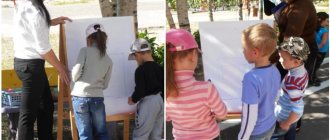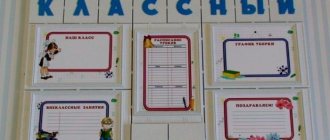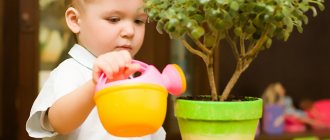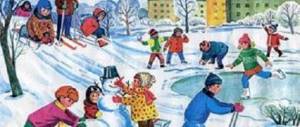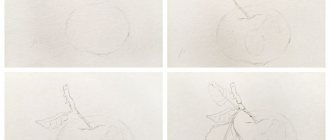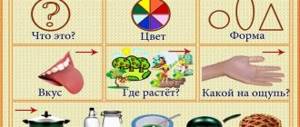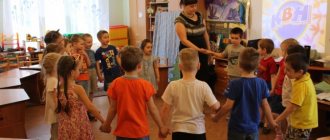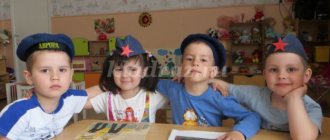Presentation on the topic Winter. Children's presentation
The content of the presentation:
№ 1
Birds are vertebrates, warm-blooded. Oviparous animals. They have a special body structure and lifestyle. Representatives of this class inhabit every ecosystem on Earth. Ornithologists study the habits and characteristics of birds.
№ 2
Wintering birds are called birds that live in the temperate and arctic zones from December to March. As a rule, many try to stay close to urban and rural buildings for easier obtaining of the necessary food and the opportunity to shelter in severe cold.
№ 3
Some birds are characterized by migration - migration is associated with changes in living conditions and breeding habits. According to the nature of migration, there are sedentary, migratory, and nomadic.
№ 4
Migratory species migrate depending on the season - from wintering sites to nesting sites. The cycle repeats itself year after year. Flight distances can be long or short. The flight can be divided into stages - these are stops for feeding and rest.
№ 5
Features of the flight route: dividing, circular, migration by riffles.
№ 6
They can migrate horizontally - if the preservation of the familiar landscape is required, vertically - to the mountains and to the lowlands and vice versa.
№ 7
Directions: in the Northern Hemisphere they fly south for the winter. This direction is typical for inhabitants of the Arctic and temperate zones. Such migration is associated with the need to search for food for the offspring - in a warmer climate there are more opportunities to feed the chicks. This is also due to the length of daylight hours - those leading a daily lifestyle have more favorable living conditions in the south.
№ 8
Many countries around the world celebrate a holiday in honor of wintering birds – International Migratory Bird Day.” Celebrated on the second Saturday in May. The initiators were ornithologists and wildlife conservationists. It is most seriously celebrated in Canada and the USA. There are similar holidays in Western Europe.
№ 9
Finches are migratory and wintering birds that are often found even in city parks in winter.
№10
Birds that constantly move in search of food, stopping only to breed, are called nomadic, and they can often be found in cities in winter - these are tits, jays, nuthatch, waxwings, siskins and others. Nomadic birds include hunting birds, which also try to be closer to humans in the winter - these are golden eagles and white-tailed eagles.
№11
Bullfinches are vagrant birds widely known and loved by many, which are often found in cities and forests, closer to the berries of rowan, hawthorn and lionized ash trees, buds.
№12
Residential birds are considered to be species of birds that have existed for centuries close to human habitation, which makes it easy to find food - these are sparrows, crows, jackdaws, and pigeons. Tits are sedentary individuals and do not change their lifestyle in winter. During cold weather, you can see strange flocks in which there are tits of various species at the same time - grenadiers, coal tits, puffy tits. But they are joined in search of food by nuthatches, pikas, wrens, and woodpeckers.
№13
Birds that lead a semi-sedentary existence move a minimum distance from their nesting sites - these include magpies, wood grouse, black grouse, buntings and others.
Summary of GCD in the middle group of kindergarten with a presentation on the topic: Winter
GCD in the middle group “On a visit to winter”
Author: Kochetkova Elena Vladimirovna teacher of the first quarter category of Municipal Educational Institution Secondary School No. 4 SP MDOU kindergarten No. 6 in Marx. Description: abstract of GCD on artistic and aesthetic development using the technique of drawing with stamps.
Purpose: the summary is intended for children of middle preschool age. Thematic week “Winter-Winter” Purpose: to create conditions for the development of cognitive activity of children. Objectives: To form ideas and enrich children’s knowledge about the winter period. Strengthen children's ability to draw conclusions and show curiosity. Develop children’s ability to classify and analyze while completing a task. Enrich ways of playful cooperation with peers. Encourage participation in joint activities with adults and peers. To develop the ability to follow the rules and conditions set by game situations, emotional responsiveness, goodwill, and physical activity of children. Foster initiative and independence in verbal communication with others. Previous work: targeted walks, looking at illustrations, memorizing poems, riddles about winter, reading fiction. Planned results: to develop practical skills in determining the season, naming the signs of winter, guessing riddles, reading poetry. Be able to reason and speak out. Methods for organizing educational activities: conversation; creating a game situation; questions; game exercise “Getting Dressed”; speech game “We are walking along the path”; finger gymnastics “Snowman”, drawing with stamps, demonstration of plot paintings. teacher's story "New Year"; making balls for the Christmas tree; driving a round dance; reflection. Equipment: phonograms “The Crunch of Snow”.
“Christmas tree”, snowflakes, artificial Christmas tree 3 tables with tinted paper for drawing paints, stamps for drawing, wet wipes for hands, brushes for painting, jars of water, Envelope with paintings depicting the holiday “New Year”, chest with balls from papier-mâché, glue, colored sand gifts for children Camera Presentation PROCEEDINGS NOD
Children enter accompanied by the recording “The Crunch of Snow”. Slide No. 2 Introductory part. Educator: It’s getting colder every day, The sun is warming less and less, There’s snow everywhere, like a fringe, - So, it’s come to us... (winter) Slide No. 3
That’s right, it’s winter in our yard now.
Fluffy silver snow lies everywhere like a white carpet! And we are all in a good mood! Guys, let's hold hands, look at each other, smile at each other and show with our whole face: eyes, cheeks, lips, nose that we have a good, joyful disposition. A smile is the key to a good mood Game “Take and Pass.” Guys, do you like to travel? Do you want to go on a trip? Today I suggest you go to the forest. It’s a long walk into the forest, and in order not to freeze on the road, you need to wear warm clothes. Game “Getting Dressed” ( imitation of the dressing process
).
We'll go for a walk with you, but it's cold in winter. I'll put on felt boots. I'll put on a hat, I'll put on a fur coat, I'll put on a scarf. I'll tie it tighter. And then beautiful, warm, fluffy, crumbs - mittens I’ll pull on my hands. Is everyone dressed? (Yes.) It's time to go to the forest for winter! Speech game We walk along the path Raise our legs higher, We walk one after another Soon we will find ourselves in winter! Slide number 4
Here we are.
Guys, look at the snowdrifts and how much snow there is! White fluffy snow swirls in the air. And he quietly falls to the ground and lies down. And in the morning the field turned white with snow, as if everything had been covered with a shroud ( slide
).
Look, a snowflake fell on your palm. Let's blow on it. Breathing exercise “Snowflake” Many snowflakes swirled Slide No. 5
Educator: The winter weather is good!
- Guys, look at what an unusual clearing there is (the children approach the table where there are blue sheets of paper). Let's play in it? -What games can you play in winter? (Children's answers) Slide No. 6, 7
-Do you want to build a snowman?
The teacher asks the children to remember how they made a snowman. - What is a Snowman made from? What geometric shape does a snowball resemble? — How many snowballs does it take to construct a Snowman? —Are all snowballs the same size? — What color paint will we need for the drawing? - How big is the circle at the bottom? - How big is the circle in the middle? - How big is the circle at the top? - What else does the Snowman have? — To draw a snowman, you need to stretch your fingers. Finger gymnastics “Snowman” We made a snowball We sculpt a lump with both hands, We made a hat on it We connect our hands in a ring and put it on our head, We attached the nose and instantly We put our fists to the nose, It turned out to be a snowman We outline the figure of a snowman with both hands Children take stamps, crumpled paper and Apply a drawing of a snowman with white paint onto a blue-tinted sheet of paper. The teacher reads the text:
We are making a snowman from fluffy snow.
Now we've rolled the first lump, (big stamp) That's how big it is. The second one is a little smaller, (smaller stamp) The third one is the head. (small stamp) The hat will be from a bucket. The nose is a carrot, and the eyes are (finished with a brush) Two cheerful coals. (beads are applied) That’s it, our snowman is ready, He looks happy. Slide No. 8
The mouth laughs from ear to ear, He makes all the children happy.
The snowman suddenly comes to life and catches up with the kids. Educator: Children, look how fluffy the Christmas tree is, but what I see is that something lies under it (Envelope with paintings depicting the New Year holiday). Winter - winter has come, it has brought a lot of snow. And frosts, and snowstorms, and fun, and fun! New Year is just around the corner Everyone's favorite holiday Everyone is waiting for His coming The quiet one and the prankster Both the old and the young are glad to meet him He will come to you and me in the winter Having passed through the blizzard, the obstacles Slide No. 9,10,11
Demonstration of plot paintings.
— What is the name of the holiday depicted in the picture? — When is New Year celebrated? — How is it customary to celebrate this holiday? The teacher summarizes the answers: - New Year is: holiday, laughter, fun. A lot of guests come to the New Year's holiday, everyone is having fun, singing songs and giving gifts. Before the New Year, every home, every city and every family decorates the green spruce with beautiful balls, toys, tinsel and garlands. That's how beautiful she can be. Slide No. 12
Or maybe we should decorate our Christmas tree in the forest?
I also grabbed toys, here is a chest with toys (papier-mâché balls blanks) Let's make these balls multi-colored Children take the balls, coat them with glue, sprinkle with colored sand, hang them on the tree - On New Year's holidays it is customary to dance in a circle. Let's do a round dance around our decorated Christmas tree. Round dance “Christmas tree”
They also decorate a beautiful Christmas tree on the streets of the city.
People will celebrate at the largest and most beautiful Christmas trees. You, too, can go with your family to a fun holiday, as they say - go to the Christmas tree. There you can listen to music, dance, eat goodies, and, if you're lucky, you'll meet the real Santa Claus Slide No. 13, 14,15, 16,17
Teacher's story Santa Claus is a kind grandfather who comes from a distant land.
Russian Santa Claus lives in an ancient Russian city called Veliky Ustyug. (Use slides to show the beauty of Russian winter nature, the ancient city of Veliky Ustyug, the mansions of Father Frost, and the fact that Father Frost rides around on a horse-drawn sleigh). He carries with him huge bags of gifts for children, which he prepares throughout the year. Santa Claus comes to the children's home and gives gifts. But since there are a lot of kids, he, unfortunately, won’t have time to come to them all. But don’t worry, if Santa Claus doesn’t come to you during the day, he will definitely come at night and put gifts under the tree. Maybe here Santa Claus came at night and left gifts for us. Slide number 18
Educator: Blizzard, frost, New Year... A miracle will happen here!
Staff, mittens, snowflakes, Frost, snow, snowdrifts, pieces of ice, Jokes, laughter, cheerful dance... Here are gifts for you! ( Children look under the Christmas tree. They find gifts
) That's how Grandfather Frost, a real wizard Guys, I suggest taking a photo near the tree and sending the photo to Santa Claus (taking pictures) Our journey to winter has ended, it's time to return to kindergarten.
(Children sit on chairs). Reflection: Did you enjoy our trip?
What was difficult? What did you like? Did you complete the task? I really enjoyed traveling with you. Presentation on the topic: Visiting Winter
We recommend watching:
Summary of educational activities for children of the middle group on the topic: Winter Physical education entertainment “Winter-winter” for children of the middle group of preschool educational institutions Summary of educational activities in the middle group on the topic: Winter Summary of organized educational activities with children of the middle group on the topic: Winter
Similar articles:
Observation “Footprints in the snow.” Middle group
Walk observation in winter in the middle group. Winter clothes
